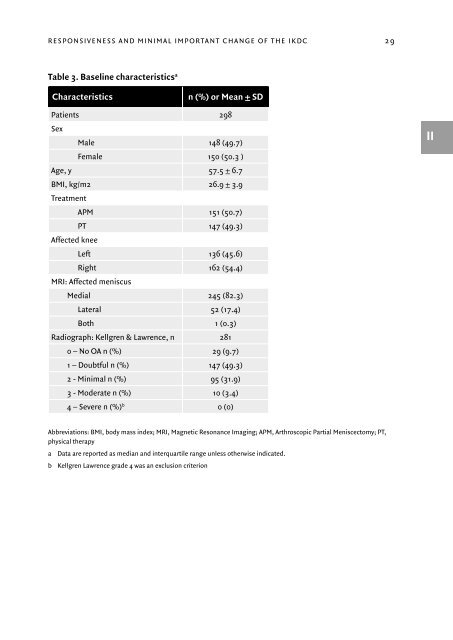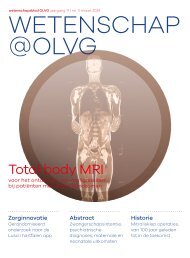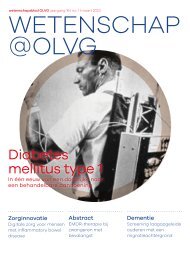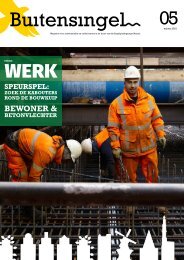Escaping the Scalpel
In-depth evidence to change clinical practice for patients with a degenerative meniscal tear. By Julia C.A. Noorduyn
In-depth evidence to change clinical practice for patients with a degenerative meniscal tear.
By Julia C.A. Noorduyn
Create successful ePaper yourself
Turn your PDF publications into a flip-book with our unique Google optimized e-Paper software.
RESPONSIVENESS AND MINIMAL IMPORTANT CHANGE OF THE IKDC29<br />
Table 3. Baseline characteristics a<br />
Characteristics<br />
n (%) or Mean ± SD<br />
Patients 298<br />
Sex<br />
Male 148 (49.7)<br />
Female 150 (50.3 )<br />
Age, y 57.5 ± 6.7<br />
BMI, kg/m2 26.9 ± 3.9<br />
Treatment<br />
APM 151 (50.7)<br />
PT 147 (49.3)<br />
Affected knee<br />
Left 136 (45.6)<br />
Right 162 (54.4)<br />
MRI: Affected meniscus<br />
Medial 245 (82.3)<br />
Lateral 52 (17.4)<br />
Both 1 (0.3)<br />
Radiograph: Kellgren & Lawrence, n 281<br />
0 – No OA n (%) 29 (9.7)<br />
1 – Doubtful n (%) 147 (49.3)<br />
2 - Minimal n (%) 95 (31.9)<br />
3 - Moderate n (%) 10 (3.4)<br />
4 – Severe n (%) b 0 (0)<br />
II<br />
Abbreviations: BMI, body mass index; MRI, Magnetic Resonance Imaging; APM, Arthroscopic Partial Meniscectomy; PT,<br />
physical <strong>the</strong>rapy<br />
a<br />
Data are reported as median and interquartile range unless o<strong>the</strong>rwise indicated.<br />
b Kellgren Lawrence grade 4 was an exclusion criterion
















